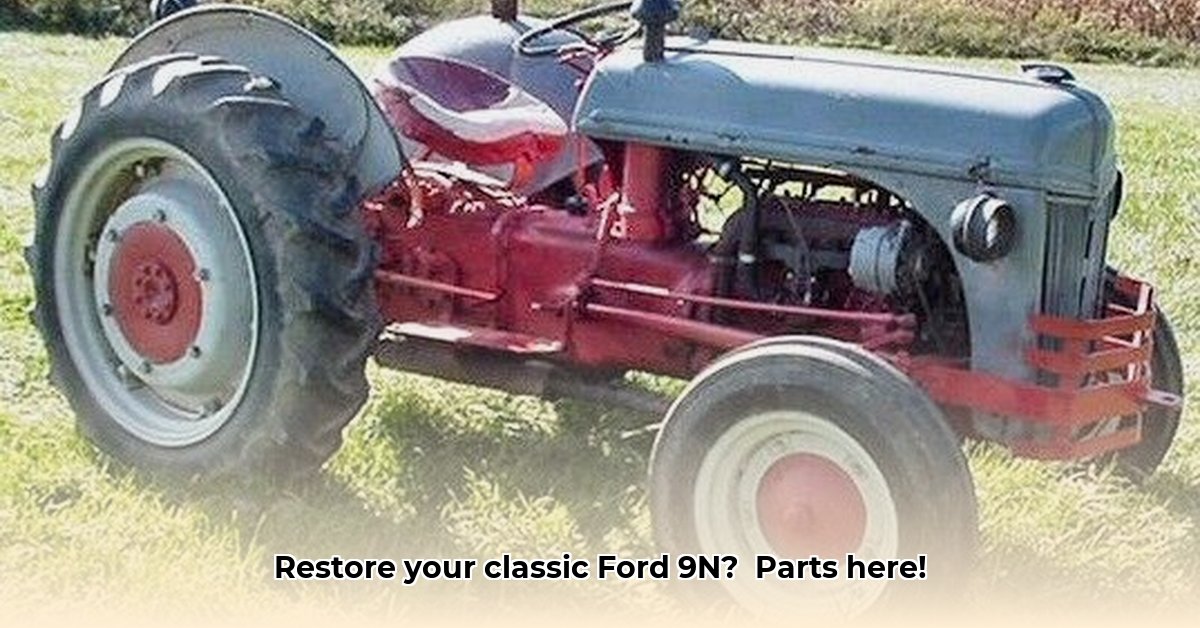
Understanding the Ford 9N Parts Market: A Complex Landscape
Restoring a Ford 9N tractor is a rewarding endeavor, but sourcing parts presents a unique challenge. The market is characterized by high demand for parts for this iconic machine, leading to a dynamic interplay of original, aftermarket, and even 3D-printed components. This makes finding the right parts a multifaceted puzzle. Original parts, manufactured during the tractor's production years, are increasingly scarce, driving up their prices. However, their superior quality and fit often justify the premium cost. Don't be surprised to find that these parts now command collector's prices. Do some research to gauge current market values. For more information on Ford tractor engines, check out this helpful resource: Ford 8N engines.
Aftermarket parts offer a more readily available and often more affordable alternative. However, quality significantly varies among suppliers. Some aftermarket companies produce high-quality replacements comparable to originals, while others offer inferior substitutions. This is a key point, as the longevity of your restoration depends on the quality of the components. Thorough research is key to making well-informed purchase decisions.
3D printing is emerging as a valuable tool for creating custom parts, particularly those that are impossible to source conventionally. While this offers solutions for unique situations, it's vital to research the quality and durability of 3D-printed components in a high-stress environment such as a tractor’s engine.
Key Takeaways:
- Original Ford 9N parts are scarce and expensive.
- Aftermarket parts vary widely in quality.
- 3D printing offers a viable but nuanced solution for unique parts.
Finding the Right Parts: A Strategic Approach
Securing the necessary parts for your Ford 9N restoration requires a strategic approach that combines several sourcing methods. Here are essential steps in sourcing the parts you need:
Original Equipment Dealers (OEDs): While OEDs are less likely to stock many Ford 9N parts, they may possess a handful of original parts left over from their inventory. These will undoubtedly be more expensive.
Online Marketplaces: Websites like eBay and dedicated online forums for classic tractor enthusiasts offer a wealth of parts. However, careful scrutiny is required to differentiate genuine parts from counterfeits. Inspect images thoroughly, and don't hesitate to inquire with the seller for additional photos or details. This step is crucial as the quality of online sellers can vary widely.
Salvage Yards: Salvage yards are like treasure chests of used parts. You might uncover hidden gems, but thorough inspection is paramount to assess the parts’ overall condition and detect any signs of wear and tear. Remember, you often get what you pay for with these parts.
3D Printing: 3D printing provides a potentially revolutionary method for creating custom replacement parts, especially for those no longer available through traditional channels. However, be sure to verify the durability and material suitability of the printed part before installation. It is critical to find a 3D printing service with experience in working with durable agricultural equipment materials.
Identifying and Assessing Part Quality: Expert Tips
Identifying original and aftermarket parts, and assessing their quality, is crucial for a successful restoration. Consider these tips:
Part Numbers: Original parts usually have distinct casting numbers or markings, which can be cross-referenced with parts manuals. Aftermarket parts might use similar, but not identical, numbers.
Material and Finish: Compare the material and finish of a part to those of known originals. Differences might indicate a reproduction or inferior quality, and should be considered before a purchase.
Online Forums: Engage in online communities dedicated to Ford 9N tractors. Experienced restorers often share identification tips and insights which can prove invaluable for assessing part quality.
Restoration Techniques and Resources: A Modern Approach
Successful Ford 9N restoration involves a blend of traditional practices and modern methods. While the use of original parts remains ideal when available, incorporating 3D printing and other alternative sourcing methods can overcome the challenges of parts scarcity. Always verify the quality and durability of any non-original parts before installation. Numerous online resources including forums and tutorials provide valuable information on modern restoration techniques.
Conclusion: Join the Ford 9N Community
Restoring your Ford 9N tractor is a journey that combines meticulous planning, skillful sourcing, and a dash of perseverance. By understanding the intricacies of the parts market, employing smart sourcing strategies, and carefully evaluating the quality of components, you can successfully bring your tractor back to life. Engage with the passionate community of Ford 9N enthusiasts for invaluable support, advice, and shared experiences. Now go get your hands dirty, and happy restoring!